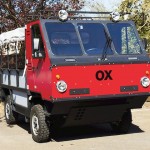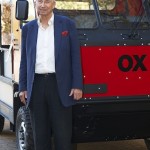
British philanthropist Sir Torquil Norman is the driving force behind an unconventional, all-terrain light truck designed specifically for remote corners of the world.
It is called the “OX” and the maker, Global Vehicle Trust (GVT), says it can be assembled from a “flat pack” of components in a matter of hours.
The first prototype has finished testing in Britain. Sir Torquil said OX was inspired by the ‘Africar’ project of the 1980s, a go-anywhere plywood vehicle invented by British journalist and film-maker Tony Howarth.
“Our sole objective at GVT is to help people in the developing world,” Sir Torquil he said.
“As part of an aid programme, the OX could provide an essential element of infrastructure to enable the local population to raise the community’s standard of living and to assert its independence by gaining control of its transportation needs and costs.
“The OX could also be an enormous help in transporting medicines, doctors, patients and other materials in emergencies and at times of natural disaster.”
Simplicity is the guiding principle behind OX. It takes three people about five hours to create the flat pack at the plant in Britain. Once it arrives at its destination, it can assembled inside 12 hours. GVT says no special skills or equipment are required.
OX is also capable of being flat-packed within itself, ensuring freight costs can be kept to a minimum. Six vehicles, including engines and transmissions, fit into a standard 40ft container.
OX has a maximum payload of two tonnes. It can seat up to 13 people, carry eight 44-gallon drums, or three large pallets. A simple power take-off can run a water pump, saw bench, or generator.
It weighs 1.5 tonnes and is about as long as a medium-sized sedan, with a high ground clearance, short front and rear overhangs, and an uncluttered underside.
A 2.2-litre diesel engine drives the front wheels via a five-speed manual transmission. Suspension is independent all-around.
GVT has spent around NZ$2 million developing the working prototype and is looking for a further NZ$6m from investors to reach production-ready stage.
“Feedback so far from contacts in Africa and with aid agencies has been very positive,” said Sir Torquil.
“Our priority now is to raise the funding to complete the testing and take the project to fruition.
“Our aim is that OX will be purchased by charities, aid organisations and development programmes, rather than private individuals.
“My dream is to one day see an OX in every village in Africa,” concludes Sir Torquil.
* AFRICAR: The chassis and bodywork were made of plywood but Howarth used Citroen engines and gearboxes and components from other carmakers, including British Leyland’s Hydrolastic suspension. Three all-wheel-drive versions were built – a station wagon, pick-up, and six-wheeler. All three were tested in 1984 on an expedition from the Arctic Circle in Norway to the equator. There was considerable interest in the project but it foundered because of financial difficulties. In July 1988 the company ceased trading. In 1994, Howarth was jailed for 15 months after pleading guilty to charges of fraudulent trading and obtaining property by deception. He now lives in the south of France.



